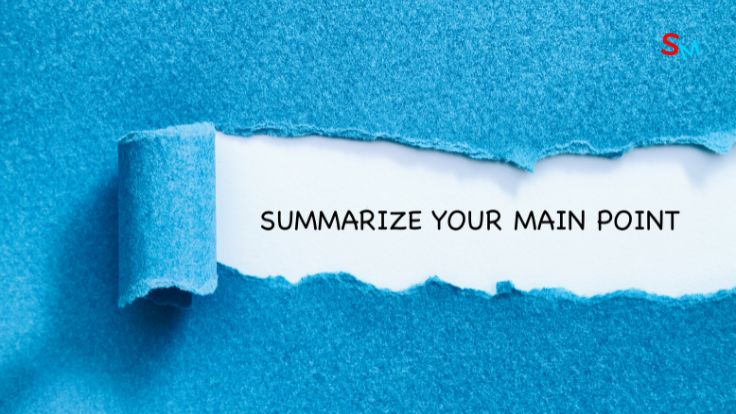As the saying goes, “The first impression is the last impression,” and when it comes to delivering a presentation, the same holds true for the closing line. A strong closing line can leave a lasting impression on your audience and can make all the difference in how your presentation is perceived. A weak or lacklustre closing line, on the other hand, can leave your audience feeling unfulfilled and uninspired.
So, The first step to knowing how to end a presentation is knowing how to craft your closing line. which is the purpose of this article. To provide you with actionable steps and tips for crafting a memorable closing line for your presentations. Whether you’re delivering a pitch, giving a speech, or presenting new findings, we’ll guide you through the process of creating a strong, effective closing line that will leave a positive impression on your audience.
By following these steps, you’ll be able to craft a closing line that not only summarizes your main message but also inspires your audience to take action or think differently. Let’s dive into the first step – knowing your audience.
Top Reads; 5 Steps To Crafting the Perfect Opening Line for Your Speech
Contents
1. Know your audience

Understanding your audience’s needs and expectations
Before crafting your closing line, it’s essential to have a good understanding of your audience’s needs and expectations. What are they hoping to gain from your presentation? What are their pain points, and how can you address them in your closing line? Understanding your audience’s needs and expectations will help you tailor your message to resonate with them.
Tailoring your closing line to your audience
Once you have a good understanding of your audience, you can tailor your closing line to resonate with them. Consider using language that your audience is familiar with, and use examples that are relevant to them. You want your closing line to feel personal and specific to your audience, so they feel like you’re speaking directly to them.
Using humour, if appropriate
Humour can be a powerful tool when used appropriately in a closing line. If your presentation has been light-hearted and playful, using a humorous closing line can leave a positive impression on your audience. However, it’s essential to ensure that the humour is appropriate for your audience and doesn’t detract from your overall message. You want your audience to remember your closing line for the right reasons, not because it was inappropriate or insensitive.
2. Summarize your key points

Revisiting your main message
One of the most critical elements of a strong closing line is revisiting your main message. Summarize your key points and restate your thesis statement in a concise and impactful way. This will reinforce the significance of your topic and help your audience remember the main takeaways from your presentation.
Reinforcing the significance of your topic
In addition to revisiting your main message, it’s essential to reinforce the significance of your topic in your closing line. Why is your topic important, and what impact will it have on your audience? By reinforcing the significance of your topic, you can inspire your audience to take action or think differently.
Avoiding introducing new information
While it may be tempting to introduce new information in your closing line, it’s important to avoid doing so. Your closing line should summarize and reinforce the information you’ve already presented, rather than introduce new information that can confuse or overwhelm your audience. Keep your closing line concise and focused on the main points you want your audience to remember.
Top Reads: 30 Powerful Ways to Start a Speech or Presentation
3. Call to action

Encouraging your audience to take action
A call to action is a critical element of a strong closing line. It encourages your audience to take action, whether it’s trying a new product, signing up for a service, or simply changing their behaviour. By providing a clear and compelling call to action, you can motivate your audience to take the next steps
Providing clear and specific instructions
To make your call to action effective, it’s essential to provide clear and specific instructions. Your audience should know exactly what they need to do and how to do it. Be specific about the steps they need to take and provide any necessary resources or links to help them take action.
Highlighting the benefits of taking action
Finally, it’s important to highlight the benefits of taking action. What will your audience gain by following your call to action? Will it save them time, improve their lives, or help them achieve their goals? By highlighting the benefits, you can make your call to action more compelling and motivate your audience to take action.
4. Using quotes and anecdotes

Incorporating relevant quotes or anecdotes
Using quotes or anecdotes in your closing line can be a powerful way to reinforce your message and leave a lasting impression on your audience. Incorporate relevant quotes or anecdotes that support your main message and help to emphasize the significance of your topic.
Telling a personal story
Telling a personal story can also be an effective way to create a memorable closing line. Sharing a personal experience that is relevant to your topic can help to create a deeper emotional connection with your audience and leave a lasting impression.
Creating an emotional connection with your audience
Finally, using quotes or anecdotes can help to create an emotional connection with your audience. By sharing a story or quote that resonates with your audience, you can tap into their emotions and leave a lasting impact. This emotional connection can help to reinforce your message and motivate your audience to take action.
Top Reads: How To Not Be Nervous For A Presentation
5. Engage your audience

Asking thought-provoking questions
Asking thought-provoking questions can be an effective way to engage your audience and make your closing line more memorable. Ask questions that challenge your audience’s assumptions or encourage them to think about your topic in a new way. This can help to keep your audience engaged and focused on your message.
Using a rhetorical device
Using a rhetorical device, such as repetition or parallelism, can also help to engage your audience and make your closing line more memorable. These devices can help to create a sense of rhythm and emphasize your message, making it more impactful.
Creating a memorable moment
Finally, creating a memorable moment can be a powerful way to engage your audience and leave a lasting impression. This could involve incorporating a surprising or unexpected element into your closing line, such as a prop or demonstration, or simply delivering your closing line in a unique and memorable way.
See Also; How Might Expectations or Rules at a Job Differ from Those at Your Home?
6. Practice and delivery

Rehearsing your closing line
Practising your closing line is crucial for delivering it confidently and effectively. Rehearse it several times, ideally in front of a mirror, to ensure you’re comfortable with the phrasing and pacing. You can also record yourself and analyze your performance to improve your delivery.
Timing your delivery
Timing is an essential element of an effective closing line. Your audience is likely to remember the beginning and end of your presentation the most, so it’s important to make the most of the time you have. Aim to deliver your closing line with enough time for your audience to process it, but not so much time that it loses impact.
Adjusting to your audience’s reactions
Finally, it’s important to be adaptable and adjust your delivery based on your audience’s reactions. If your audience seems engaged and receptive, you can deliver your closing line with confidence and enthusiasm. If they seem disinterested or distracted, you may need to adjust your delivery to re-engage them.
Top Reads: 5 Steps To Crafting the Perfect Opening Line for Your Speech
Conclusion
Crafting a strong closing line is crucial for leaving a lasting impression on your audience and motivating them to take action.
By putting these tips into practice, you can create a closing line that resonates with your audience and leaves a lasting impression. Remember to practice your delivery and adjust based on your audience’s reactions, and don’t be afraid to incorporate thought-provoking questions, rhetorical devices, or memorable moments.
In conclusion, If You want to know how to end a presentation, crafting a strong closing line is essential for delivering an effective presentation. By following the tips outlined in this article, you can create a memorable and impactful closing line that motivates your audience to take action.
[…] Top Reads: How To End A Presentation-Crafting Your Closing Line […]